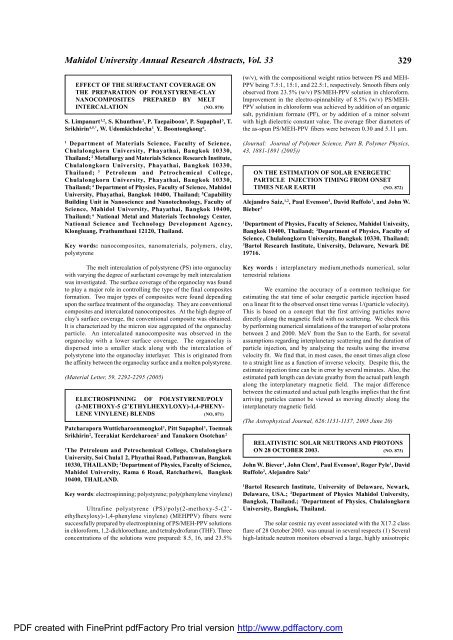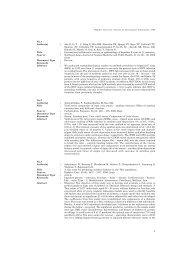Faculty of Science - Mahidol University
Faculty of Science - Mahidol University
Faculty of Science - Mahidol University
You also want an ePaper? Increase the reach of your titles
YUMPU automatically turns print PDFs into web optimized ePapers that Google loves.
<strong>Mahidol</strong> <strong>University</strong> Annual Research Abstracts, Vol. 33 329<br />
EFFECT OF THE SURFACTANT COVERAGE ON<br />
THE PREPARATION OF POLYSTYRENE-CLAY<br />
NANOCOMPOSITES PREPARED BY MELT<br />
INTERCALATION (NO. 870)<br />
S. Limpanart 1,2 , S. Khunthon 2 , P. Taepaiboon 3 , P. Supaphol 3 , T.<br />
Srikhirin 4,5,* , W. Udomkichdecha 1<br />
, Y. Boontongkong6 .<br />
1 Department <strong>of</strong> Materials <strong>Science</strong>, <strong>Faculty</strong> <strong>of</strong> <strong>Science</strong>,<br />
Chulalongkorn <strong>University</strong>, Phayathai, Bangkok 10330,<br />
Thailand; 2 Metallurgy and Materials <strong>Science</strong> Research Institute,<br />
Chulalongkorn <strong>University</strong>, Phayathai, Bangkok 10330,<br />
Thailand; 3 Petroleum and Petrochemical College,<br />
Chulalongkorn <strong>University</strong>, Phayathai, Bangkok 10330,<br />
Thailand; 4 Department <strong>of</strong> Physics, <strong>Faculty</strong> <strong>of</strong> <strong>Science</strong>, <strong>Mahidol</strong><br />
<strong>University</strong>, Phayathai, Bangkok 10400, Thailand; 5 Capability<br />
Building Unit in Nanoscience and Nanotechnology, <strong>Faculty</strong> <strong>of</strong><br />
<strong>Science</strong>, <strong>Mahidol</strong> <strong>University</strong>, Phayathai, Bangkok 10400,<br />
Thailand; 6 National Metal and Materials Technology Center,<br />
National <strong>Science</strong> and Technology Development Agency,<br />
Klongluang, Prathumthani 12120, Thailand.<br />
Key words: nanocomposites, nanomaterials, polymers, clay,<br />
polystyrene<br />
The melt intercalation <strong>of</strong> polystyrene (PS) into organoclay<br />
with varying the degree <strong>of</strong> surfactant coverage by melt intercalation<br />
was investigated. The surface coverage <strong>of</strong> the organoclay was found<br />
to play a major role in controlling the type <strong>of</strong> the final composites<br />
formation. Two major types <strong>of</strong> composites were found depending<br />
upon the surface treatment <strong>of</strong> the organoclay. They are conventional<br />
composites and intercalated nanocomposites. At the high degree <strong>of</strong><br />
clay’s surface coverage, the conventional composite was obtained.<br />
It is characterized by the micron size aggregated <strong>of</strong> the organoclay<br />
particle. An intercalated nanocomposite was observed in the<br />
organoclay with a lower surface coverage. The organoclay is<br />
dispersed into a smaller stack along with the intercalation <strong>of</strong><br />
polystyrene into the organoclay interlayer. This is originated from<br />
the affinity between the organoclay surface and a molten polystyrene.<br />
(Material Letter, 59, 2292-2295 (2005)<br />
ELECTROSPINNING OF POLYSTYRENE/POLY<br />
(2-METHOXY-5 (2’ETHYLHEXYLOXY)-1,4-PHENY-<br />
LENE VINYLENE) BLENDS (NO, 871)<br />
Patcharaporn Wutticharoenmongkol 1 , Pitt Supaphol 1 , Toemsak<br />
Srikhirin 2 , Teerakiat Kerdcharoen 2 and Tanakorn Osotchan 2<br />
1 The Petroleum and Petrochemical College, Chulalongkorn<br />
<strong>University</strong>, Soi Chula1 2, Phyathai Road, Pathumwan, Bangkok<br />
10330, THAILAND; 2 Department <strong>of</strong> Physics, <strong>Faculty</strong> <strong>of</strong> <strong>Science</strong>,<br />
<strong>Mahidol</strong> <strong>University</strong>, Rama 6 Road, Ratchathewi, Bangkok<br />
10400, THAILAND.<br />
Key words: electrospinning; polystyrene; poly(phenylene vinylene)<br />
Ultrafine polystyrene (PS)/poly(2-methoxy-5-(2’ethylhexyloxy)-1,4-phenylene<br />
vinylene) (MEHPPV) fibers were<br />
successfully prepared by electrospinning <strong>of</strong> PS/MEH-PPV solutions<br />
in chlor<strong>of</strong>orm, 1,2-dichloroethane, and tetrahydr<strong>of</strong>uran (THF). Three<br />
concentrations <strong>of</strong> the solutions were prepared: 8.5, 16, and 23.5%<br />
(w/v), with the compositional weight ratios between PS and MEH-<br />
PPV being 7.5:1, 15:1, and 22.5:1, respectively. Smooth fibers only<br />
observed from 23.5% (w/v) PS/MEH-PPV solution in chlor<strong>of</strong>orm.<br />
Improvement in the electro-spinnability <strong>of</strong> 8.5% (w/v) PS/MEH-<br />
PPV solution in chlor<strong>of</strong>orm was achieved by addition <strong>of</strong> an organic<br />
salt, pyridinium formate (PF), or by addition <strong>of</strong> a minor solvent<br />
with high dielectric constant value. The average fiber diameters <strong>of</strong><br />
the as-spun PS/MEH-PPV fibers were between 0.30 and 5.11 µm.<br />
(Journal: Journal <strong>of</strong> Polymer <strong>Science</strong>, Part B, Polymer Physics,<br />
43, 1881-1891 (2005))<br />
ON THE ESTIMATION OF SOLAR ENERGETIC<br />
PARTICLE INJECTION TIMING FROM ONSET<br />
TIMES NEAR EARTH (NO. 872)<br />
Alejandro Saiz, 1,2 , Paul Evenson 3 , David Ruffolo 1 , and John W.<br />
Bieber 3<br />
1 Department <strong>of</strong> Physics, <strong>Faculty</strong> <strong>of</strong> <strong>Science</strong>, <strong>Mahidol</strong> Univesity,<br />
Bangkok 10400, Thailand; 2 Department <strong>of</strong> Physics, <strong>Faculty</strong> <strong>of</strong><br />
<strong>Science</strong>, Chulalongkorn <strong>University</strong>, Bangkok 10330, Thailand;<br />
3 Bartol Research Institute, <strong>University</strong>, Delaware, Newark DE<br />
19716.<br />
Key words : interplanetary medium,methods numerical, solar<br />
terrestrial relations<br />
We examine the accuracy <strong>of</strong> a common technique for<br />
estimating the stat time <strong>of</strong> solar energetic particle injection based<br />
on a linear fit to the observed onset time versus 1/(particle velocity).<br />
This is based on a concept that the first arriving particles move<br />
directly along the magnetic field with no scattering. We check this<br />
by performing numerical simulations <strong>of</strong> the transport <strong>of</strong> solar protons<br />
between 2 and 2000. MeV from the Sun to the Earth, for several<br />
assumptions regarding interplanetary scattering and the duration <strong>of</strong><br />
particle injection, and by analyzing the results using the inverse<br />
velocity fit. We find that, in most cases, the onset times align close<br />
to a straight line as a function <strong>of</strong> inverse velocity. Despite this, the<br />
estimate injection time can be in error by several minutes. Also, the<br />
estimated path length can deviate greathy from the actual path length<br />
along the interplanetary magnetic field. The major difference<br />
between the estimazted and actual path lengths implies that the first<br />
arriving particles cannot be viewed as moving directly along the<br />
interplanetary magnetic field.<br />
(The Astrophysical Journal, 626:1131-1137, 2005 June 20)<br />
RELATIVISTIC SOLAR NEUTRONS AND PROTONS<br />
ON 28 OCTOBER 2003. (NO. 873)<br />
John W. Biever 1 , John Clem 1 , Paul Evenson 1 , Roger Pyle 1 , David<br />
Ruffolo 2 , Alejandro Saiz 3<br />
1 Bartol Research Institute, <strong>University</strong> <strong>of</strong> Delaware, Newark,<br />
Delaware, USA.; 2 Department <strong>of</strong> Physics <strong>Mahidol</strong> <strong>University</strong>,<br />
Bangkok, Thailand.; 3 Department <strong>of</strong> Physics, Chulalongkorn<br />
<strong>University</strong>, Bangkok, Thailand.<br />
The solar cosmic ray event associated with the X17.2 class<br />
flare <strong>of</strong> 28 October 2003. was unusal in several respects (1) Several<br />
high-latitude neutron monitors observed a large, highly anisotropic<br />
PDF created with FinePrint pdfFactory Pro trial version http://www.pdffactory.com
















